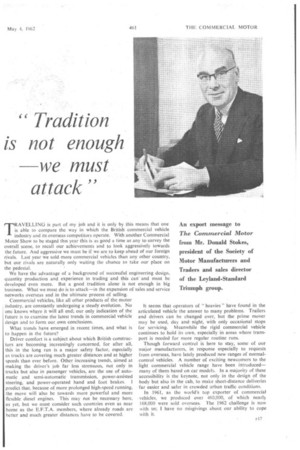"Tradition is not enough we must attack"
Page 99

If you've noticed an error in this article please click here to report it so we can fix it.
TRAVELLING is part of my job and it is only by this means that one is able to compare the way in which the British commercial vehicle industry and its overseas competitors operate. With another Commercial Motor Show to be staged this year this is as good a time as any to survey the overall scene, to recall our achievements and to look aggressively towards the future. And aggressive we must be if we are to keep ahead of our foreign rivals. Last year we sold more commercial vehicles than any other country, but our rivals are naturally only waiting the chance to take our place on the pedestal.
What trends have emerged in recent times, to happen in the future?
Driver comfort is a subject about which British constructors are becoming increasingly concerned, for after all, this in the long run is a major safety factor, especially as trucks are covering much greater distances and at higher speeds than ever before. Other increasing trends, aimed at making the driver's job far less strenuous, not only in trucks but also in passenger vehicles, are the use of automatic and semi-automatic transmission, power-assisted steering, and power-operated hand and foot brakes. I predict that, because of more prolonged high-speed running, the move will also be towards more powerful and more flexible diesel engines. This may not be necessary here, as yet, but we must consider such countries even as near home as the E.F.T.A. members, where already roads are better and much greater distances have to be covered. • and what is It seems that operators of " heavies" have found in the articulated vehicle the answer to many problems. Trailers and drivers can be changed over, but the prime mover may be used, day andnight, with only occasional stops for servicing. Meanwhile the rigid commercial vehicle continues to hold its own, especially in areas where transport is needed for more regular routine runs.
Though forward control is here to stay, some of our major manufacturers, in response especially to requests from overseas, have lately produced new ranges of normalcontrol vehicles. A number of exciting newcomers to the light commercial vehicle range have been introduced— many of them based on car models. In a majority of these accessibility is the keynote, not only in the design of the body but also in the cab, to make short-distance deliveries far easier and safer in crowded urban traffic conditions.
In 1961, as the world's top exporter of commercial . vehicles, we produced over 460,000, of which nearly 168,000 were sold overseas. The 1962 challenge is now with us; I have no misgivings about our ability to cope with it.


































































































































































































































































